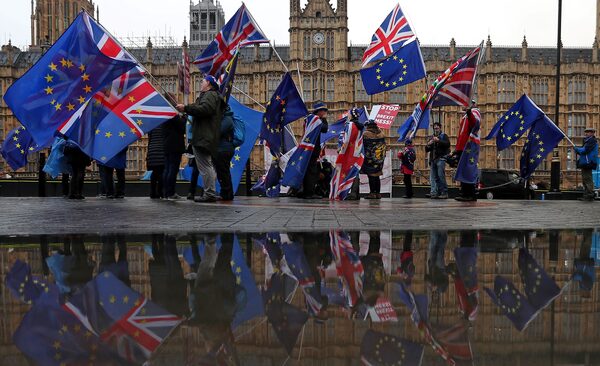
Dec. 3, 2018: Pro- and anti-Brexit demonstrators wave flags across from the Houses of Parliament in London. MPs decide on Dec. 11 whether to approve the draft separation agreement Prime Minister Theresa May reached with the European Union in November.DANIEL LEAL-OLIVAS/AFP/Getty Images
Britain faces a historic moment soon. Prime Minister Theresa May’s Brexit deal with European Union is coming up for a vote in the House of Commons on Tuesday and the outcome is far from certain. With about two months to go before the country leaves the EU on March 29, the stakes couldn’t be higher. Ms. May’s deal is widely unpopular, the EU is refusing to renegotiate and no one has a credible “plan B.”
Since fending off a leadership challenge from her Conservative Party colleagues in December, Ms. May has been scrambling to win consensus in Parliament and concessions from EU leaders. Meanwhile, businesses are scrambling to prepare for an uncertain future and some families have started stockpiling food and medicine in preparation for a worst-case scenario.

What are they voting on?
The deal has two parts; a 585-page legally binding withdrawal agreement, which outlines the terms of the United Kingdom’s departure, and a 26-page “political declaration” setting the framework for negotiations on a future economic relationship. The agreement can pass through a simple majority. But that is not going to be easy.

Why is it hard to win Parliament’s approval?
First let’s look at the arithmetic. Ms. May’s Conservatives don’t hold a majority of seats in the 650-seat House of Commons and about 100 Tory MPs, roughly one-third of the caucus, have come out against the agreement. Ms. May’s allies, Northern Ireland’s Democratic Unionist Party, have been propping up the government, but the DUP has balked too, making the numbers even more challenging.

Britain heads for historic
Brexit ballot
The British House of Commons is to vote on a
Brexit deal with the EU Tuesday. The deal is
expected to be rejected by a margin of as many
as 100 MPs, including 60 Conservatives.
How parties may vote in 650-seat lower chamber
Speaker
Has casting vote
(last used in 1980)
Conservatives: 315
As many as 60 could
vote against
Labour: 257
Up to 10 rebels could
support deal
50
100
150
200
250
300
Scottish National Party: 35
Democratic Unionist
Party*: 10
Suggested it will
vote against
Liberal Democrats: 12
Independent: 8
Plaid Cymru: 4
Green Party: 1 Will vote against
Sinn Féin: 7
Abstentionist policy – will not vote
*Conservatives and DUP have “confidence and supply” agreement
which includes supporting government legislation pertaining
to UK’s exit from EU
the globe and mail, Sources: graphic news;
UK Parliament; Stratfor

Britain heads for historic Brexit ballot
The British House of Commons is to vote on a Brexit deal
with the EU Tuesday. The deal is expected to be rejected by
a margin of as many as 100 MPs, including 60 Conservatives.
How parties may vote in 650-seat lower chamber
Speaker
Has casting vote
(last used in 1980)
Conservatives: 315
As many as 60 could
vote against
Labour: 257
Up to 10 rebels could
support deal
50
100
150
200
250
300
Scottish National Party: 35
Democratic Unionist
Party*: 10
Suggested it will
vote against
Liberal Democrats: 12
Independent: 8
Plaid Cymru: 4
Green Party: 1 Will all vote against
Sinn Féin: 7
Abstentionist policy – will not vote
*Conservatives and DUP have “confidence and supply” agreement
which includes supporting government legislation pertaining
to UK’s exit from EU
the globe and mail, Sources: graphic news;
UK Parliament; Stratfor

Britain heads for historic Brexit ballot
The British House of Commons is to vote on a Brexit deal with the EU Tuesday.
The deal is expected to be rejected by a margin of as many as 100 MPs,
including 60 Conservatives.
How parties may vote in 650-seat lower chamber
Speaker
Has casting vote (last used in 1980)
Labour: 257
Up to 10 rebels could support deal
Conservatives: 315
As many as 60 could vote against
50
100
150
200
250
300
Scottish National Party: 35
Democratic Unionist Party*: 10
Suggested it will vote against
Liberal Democrats: 12
Independent: 8
Plaid Cymru: 4
Green Party: 1 Will all vote against
*Conservatives and DUP have “confidence
and supply” agreement which includes
supporting government legislation
pertaining to UK’s exit from EU
Sinn Féin: 7
Abstentionist policy – will not vote
the globe and mail, Sources: graphic news; UK Parliament; Stratfor
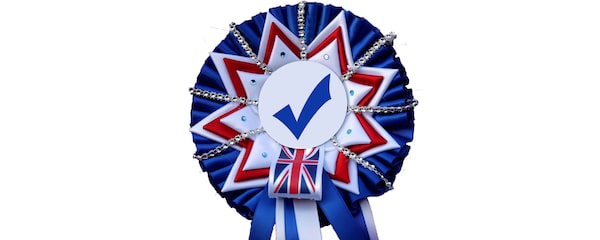
What if there’s a Yes vote?
Okay, let’s say Ms. May manages to squeak through and the deal is approved. The European Parliament has to approve it too, which is a a virtual certainty, and the U.K. will leave the EU at midnight Brussels time on March 29. Then the work really starts. The U.K. and EU immediately begin negotiations on a future economic relationship, covering everything from trade to security and regulatory standards. The U.K. would remain in the EU while the talks proceeded, and if an agreement has not been reached by the end of 2020, the deadline can be extended for up to two years. If they still haven’t reached an agreement (and that’s likely since trade deals take an average of four years to conclude) a “backstop” kicks in until they do have a deal. Under the backstop, the U.K. would essentially remain within the EU customs union, which provides for the free movement of goods, and Northern Ireland would have closer alignment with the EU in order to maintain an open border with Ireland. Once a deal was reached, it would have to be ratified by the U.K. and every EU member state.

What if there’s a No vote?
If Ms. May loses the vote, the government has three working days to come back with something different. If that also fails, Members of Parliament will take over the Brexit process and propose a range of alternatives. That leaves open a host of possibilities.
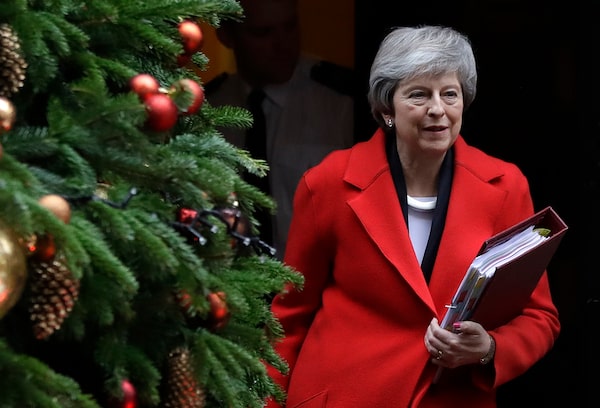
Prime Minister Theresa May.Kirsty Wigglesworth/The Associated Press
Ms. May quits
If the No vote is overwhelming, Ms. May could resign or be forced out as party leader. Given her tenacious personality, she’s unlikely to quit, and pushing her out isn’t easy. Rebel Tories have already failed once to garner enough support among their colleagues to force a leadership vote, and many say replacing her in the midst of the turmoil would be even more destabilizing. And there’s no clear alternative. Tory MPs haven’t settled on an obvious candidate to replace her.
An election
The Tories don’t want an election and the right-wing DUP also isn’t keen, fearing a Labour victory. Ms. May doesn’t have the leverage of calling a snap vote, either. Under a fixed-term law adopted in 2011, she can only call an early election with the backing of two-thirds of MPs, which isn’t likely. That leaves the next election on May 5, 2022, as scheduled.
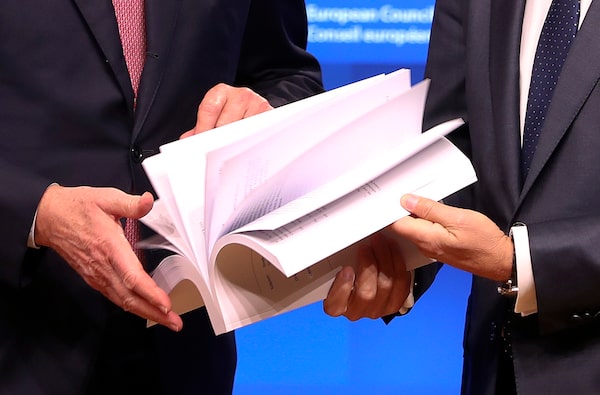
The text of the draft Brexit withdrawal is held by EU chief Brexit negotiator Michel Barnier, left, and European Council President Donald Tusk.Francisco Seco/The Associated Press
A tweak or two
If the vote is close, Ms. May could try to tweak the deal to win over critics. She could try to extend the March 29 deadline to keep talking, but the EU would have to approve an extension. One solution is to change the backstop. It’s the biggest source of opposition because many MPs feel it binds the U.K., and especially Northern Ireland, too closely to the EU for an indefinite period of time. And it can be terminated only with agreement from the EU, which infuriates MPs who believe that curtails the country’s sovereignty. Changing the termination clause might pacify some MPs, but the EU has said the deal agreed is final.
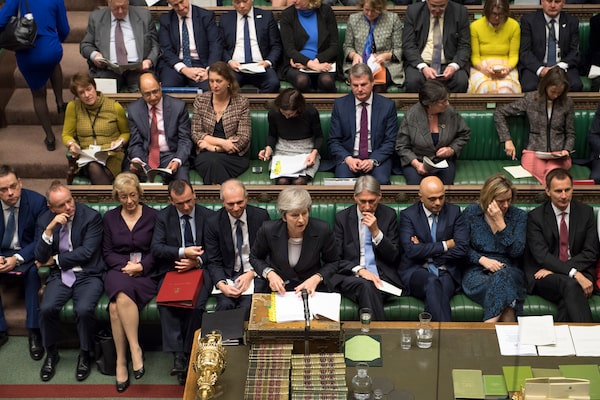
Ms. May, centre foreground, makes a reply to lawmakers during Question Time in the House of Commons on Dec. 5.Mark Duffy/The Associated Press
MPs take charge
Ms. May’s government lost a key motion last year that gave MPs more of a say in the Brexit process. That could come back to haunt her because it means that whatever Ms. May proposes as an alternative, MPs from all parties can amend it and put forward their own plan. Some MPs believe there’s enough cross-party support for another Brexit referendum or a Norway-style option, which would see the U.K. remain within most of the EU’s structure. However, there are pitfalls. The Norway option would mean accepting the EU’s principle of free movement of people, which doesn’t have wide support among MPs and was one of the main issues in the Brexit referendum in 2016. Holding another referendum could be tricky, too, because it’s not clear what question would be asked or whether the country even wants another vote.
No deal
One scenario is for Ms. May to do nothing if the deal is voted down. That would mean the U.K. would leave the EU on March 29 without an agreement. Many business leaders and economists say that would damage the economy because the U.K. could suddenly face stiff tariff and non-tariff barriers put up by the EU, the U.K.’s largest trading partner. But some Brexiters wouldn’t mind a no-deal exit. They believe the country should drop the agreement, follow World Trade Organization rules and sign trade deals with the United States, Canada and other countries.
Return to the fold
The European Court of Justice has been hearing arguments about whether the U.K. could unilaterally revoke Article 50, the clause in the Lisbon Treaty Ms. May used last year to trigger Brexit. Last month, the court’s advocate-general said the U.K. could revoke Brexit without permission from EU member states. That’s not a ruling, but the court generally follows the advocate-general’s advice.
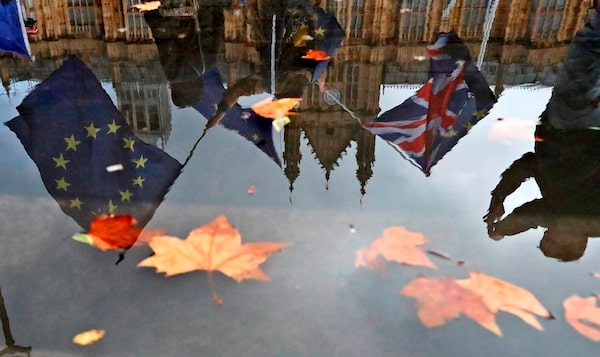
In front of the Houses of Parliament, protesters are reflected in a puddle of rainwater as they wave European flags to demonstrate against Brexit.Frank Augstein/The Associated Press
Photo illustrations by The Globe and Mail (Image source: Reuters)
 Paul Waldie
Paul Waldie